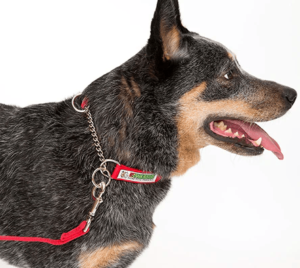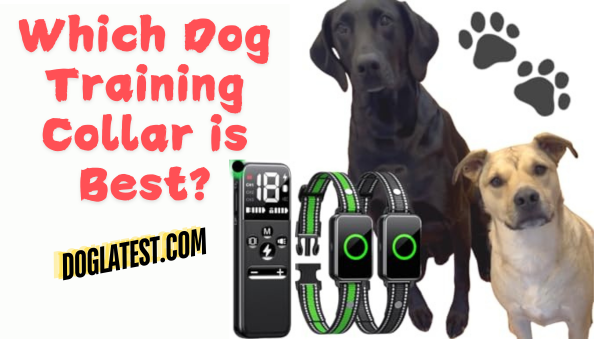Introduction:
Choosing the right dog training collar is essential for ensuring effective training and maintaining the well-being of your furry friend. A suitable collar can significantly impact your dog’s behavior, providing guidance and correction as needed.
Why Choosing the Right Dog Training Collar is Important
Selecting the appropriate dog training collar is crucial because it directly affects the efficiency and comfort of your dog during training sessions. The right collar can foster better communication and quicker learning, making training a more positive experience for both you and your pet.
The Impact of Training Collars on Your Dog’s Behavior
Training collars can influence your dog’s behavior by reinforcing commands and discouraging unwanted actions. Consistent use can help develop obedience, reduce behavioral issues, and enhance the overall bond between you and your dog.
Safety Considerations for Your Dog
When choosing a dog training collar, safety should be a top priority. Ensure the collar is comfortable, fits properly, and is used according to the manufacturer’s guidelines. Avoid collars that cause pain or discomfort, as these can lead to fear and anxiety.
Read More: Shock Collars for Dog
Understanding Dog Training Collars:

Dog training collars come in various types, each designed for specific training purposes. Understanding the differences and their intended use is key to selecting the right one for your dog.
What is a Dog Training Collar?
Definition and Purpose:
A dog training collar is a device used to assist in training dogs by providing various forms of correction or guidance. Its primary purpose is to help teach commands and discourage unwanted behavior.
History of Dog Training Collars:
Dog training collars have evolved over time, with early versions being simple leather straps to modern electronic devices. Innovations in design and technology have improved their effectiveness and safety.
Read More: When to Start E-Collar Training?
Types of Dog Training Collars:
Standard Collars:
Standard collars are basic collars used for everyday wear. They are not typically used for training but are essential for attaching identification tags.
Electronic Collars:
Electronic collars, or e-collars, use mild electrical stimulation to gain the dog’s attention and correct behavior. They are often used for remote training and to reinforce commands.
Spray Collars:
Spray collars emit a burst of citronella or another harmless spray to deter unwanted behavior. They are commonly used for barking control.
Vibrating Collars:
Vibrating collars use vibrations to interrupt unwanted behavior or gain the dog’s attention. They are often used as a gentler alternative to electronic collars.
Ultrasonic Collars:
Ultrasonic collars emit a high-pitched sound that is unpleasant to dogs but inaudible to humans. They are used to deter behaviors like excessive barking.
Prong Collars:
Prong collars, also known as pinch collars, have metal prongs that provide a pinching sensation when the dog pulls. They are used for training purposes but require careful use to avoid injury.
Martingale Collars:
Martingale collars tighten when the dog pulls, preventing escape without choking. They are ideal for dogs with narrow heads, such as greyhounds, and provide more control than standard collars.
Read More: What is the Best Bark Collar for Small Dogs?
Evaluating Different Good Dog Training Collars:

Electronic Collars (E-Collars):
How They Work Electronic collars, or e-collars, function by delivering mild electrical stimulation to the dog through contact points on the collar. The stimulation is controlled by a remote, allowing the trainer to correct behavior at a distance.
Pros and Cons
Pros:
- Effective for remote training
- Can quickly correct unwanted behaviors
- Adjustable intensity levels
Cons:
- Can cause anxiety or fear if misused
- Requires careful and knowledgeable use
- Potential for misuse or overuse
Recommended Breeds and Behaviors E-collars are particularly useful for high-energy breeds, working dogs, and those requiring off-leash training. They are effective for addressing behaviors like excessive barking, aggression, and poor recall.
Spray Collars:
Mechanism of Action Spray collars release a burst of citronella or another harmless substance when the dog exhibits undesirable behavior, such as barking. The unpleasant sensation deters the behavior.
Benefits and Drawbacks
Benefits:
- Humane and painless
- Easy to use
- Effective for barking control
Drawbacks:
- Limited range of behavior correction
- May not work on all dogs
- Refill cartridges needed
Suitable Scenarios for Use Spray collars are best suited for controlling nuisance barking and can be used in various environments, including at home and in public spaces.
Vibrating Collars:
How Vibrations Can Aid in Training: Vibrating collars use vibrations to interrupt unwanted behaviors or to get the dog’s attention. The sensation is gentle and non-painful, making it a humane option.
Pros and Cons:
Pros:
- Gentle and humane
- Good for deaf dogs
- Effective for mild behavior correction
Cons:
- Limited to short-range corrections
- Maybe not suitable for all canines
- Batteries required
Best Practices for Using Vibrating Collars: To use vibrating collars effectively, start with low-intensity settings and gradually increase if needed. Use consistent commands and positive reinforcement to complement the collar’s use.
Ultrasonic Collars:
How They Operate Ultrasonic collars emit a high-frequency sound that is unpleasant to dogs but inaudible to humans. The sound is triggered by specific behaviors, like barking.
Advantages and Disadvantages
Advantages:
- Humane and non-painful
- Effective for barking control
- Inaudible to humans
Disadvantages:
- Maybe not suitable for all canines.
- Limited behavior correction range
- Potential for other sounds to trigger the device
Ideal Situations for Use Ultrasonic collars are ideal for controlling excessive barking in a home environment. They are particularly useful for apartment dwellers where noise control is important.
Prong Collars:
Description and Function Prong collars, or pinch collars, have interlocking metal links with prongs that pinch the dog’s neck when tension is applied. They provide a physical correction that mimics a mother dog’s bite.
Controversies and Considerations Prong collars are controversial due to their potential to cause injury if misused. They should be used under the guidance of a professional trainer and never for prolonged periods.
Appropriate Usage Guidelines When using prong collars, ensure a proper fit and use gentle corrections. Always pair with positive reinforcement and consult a professional trainer for best practices.
Martingale Collars:
How They Differ from Other Collars Martingale collars tighten when the dog pulls, providing gentle correction without choking. They consist of a fabric or chain loop that prevents the dog from slipping out of the collar.
Benefits and Limitations
Benefits:
- Prevents escape
- Gentle correction
- Ideal for narrow-headed breeds
Limitations:
- Limited to on-leash training
- Not suitable for severe behavior issues
Specific Use Cases Martingale collars are ideal for dogs with narrow heads, like greyhounds, and for on-leash training in controlled environments. They provide more control than standard collars without the risk of choking.
Key Features to Consider:
Adjustability:
Importance of Proper Fit: Choosing a collar with adjustable features is crucial for ensuring a proper fit. An improperly fitting collar may irritate the skin, create pain, or even break someone. Proper fit enhances the effectiveness of training and ensures your dog’s safety and comfort.
How to Measure Your Dog for a Collar: To measure your dog for a collar, use a flexible tape measure. At the point where the collar will rest on your dog’s neck, wrap it around. Make sure to leave enough room for two fingers to slide comfortably between the collar and the dog’s neck. This guarantees a close-fitting but cozy fit.
Material and Durability:
Types of Materials Used: Dog training collars come in various materials, including nylon, leather, biomethane, and metal. Nylon collars are lightweight and affordable, leather collars are durable and stylish, biomethane is waterproof and easy to clean, and metal prong collars are strong and effective for training purposes.
Durability and Maintenance Tips: The durability of a collar depends on the material and construction quality. To extend the life of the collar, clean it regularly according to the manufacturer’s instructions. For nylon and biomethane collars, mild soap and water suffice. Leather collars require conditioning to prevent cracking. Regular inspection for wear and tear is also important.
Comfort and Safety:
Ensuring Your Dog’s Comfort: Comfort is essential when selecting a training collar. Look for collars with padded or smooth edges to prevent chafing. Ensure that the collar is not too tight, allowing for easy movement and breathability. A comfortable collar makes training a more positive experience for your dog.
Safety Features to Look For: Safety features in training collars can include quick-release buckles, reflective materials for visibility, and rounded edges to prevent injury. Some collars also have built-in safety mechanisms that prevent excessive tightening, ensuring your dog’s well-being during training sessions.
Ease of Use:
User-Friendly Features: User-friendly features in dog training collars can make a significant difference. Look for collars with easy-to-use buckles, clear settings, and intuitive controls. Remote trainers should have simple interfaces and ergonomic designs for comfortable handling.
Dog Training Collar Dog Settings and Controls: Modern training collars come with various settings and controls, including adjustable intensity levels, tone or vibration modes, and safety locks. These features allow for customized training tailored to your dog’s needs and behavior, enhancing the effectiveness of the training process.
Price and Value:
Cost vs. Benefits: When evaluating training collars, consider the cost versus the benefits they offer. Higher-priced collars often come with advanced features and better durability. However, many budget-friendly options provide excellent value without compromising on essential features.
Budget-Friendly Options: For those on a budget, look for collars that offer basic yet effective features. Many affordable collars provide adequate durability, comfort, and adjustability. Prioritize essential features over luxury extras to find a collar that fits your needs and budget.
How to Use Dog Training Collar effectively?
Introduction to Training with Collars:
Training your dog with a collar can be highly effective when done correctly. Preparing your dog for collar training involves introducing the collar gradually and ensuring it fits properly. Initial steps and precautions include familiarizing your dog with the collar and using it consistently during training sessions.
Basic Training Techniques:
Positive reinforcement methods are essential for successful training. Combine collar use with commands to reinforce desired behaviors. Use treats, praise, and affection to reward your dog, creating a positive association with the collar and commands.
Advanced Training Tips:
For more advanced training, address specific behavioral issues such as barking or aggression. Gradually advance the training by increasing the complexity of commands and using the collar to reinforce these behaviors consistently.
Common Mistakes to Avoid:
Avoid overusing or misusing collars, as this can cause fear or anxiety in your dog. Misinterpreting your dog’s reactions can lead to ineffective training. Pay close attention to your dog’s responses and adjust your methods accordingly to ensure a positive training experience.
FAQs:
Are Training Collars Safe for All Dogs?
Training collars are generally safe for most dogs, but age, breed, and health considerations are important. Puppies under six months, small breeds, and dogs with pre-existing health conditions may require special care. Always consult with a veterinarian before using a training collar on your dog.
How Long Should Dog Training Collar Sessions Be?
Optimal training sessions should last between 10 to 15 minutes and be conducted 2 to 3 times a day. Short, frequent sessions are more effective and less stressful for your dog, promoting better learning and retention of commands.
Can Training Collars Be Used for Aggressive Dogs?
Training collars can be used for aggressive dogs, but precautions and alternatives should be considered. Professional guidance is recommended to ensure safe and effective use. Alternatives such as positive reinforcement and behavior modification techniques can also be beneficial.
What is the best collar for my dog? How can I tell?
Assess your dog’s needs and behavior to determine the best collar. Consider factors like your dog’s size, temperament, and specific training goals. Research various collar types and consult with a professional trainer for personalized recommendations.
What Should I Do if My Dog is Not Responding to the Collar?
If your dog is not responding to the collar, troubleshooting tips include checking the fit and functionality of the collar, ensuring you’re using the correct settings, and pairing the collar with positive reinforcement. Consulting with a professional trainer can also provide additional insights and strategies.
Conclusion:
Making the Right Choice for Your Dog
Summarizing Key Points
Choosing the right dog training collar is essential for effective training and your dog’s well-being. We’ve covered the importance of proper fit, understanding different types of collars, and considering factors like comfort, safety, and ease of use. Effective training combines these collars with positive reinforcement and consistent techniques.
Encouraging Informed Decisions
Making an informed decision involves assessing your dog’s specific needs, consulting with professionals, and understanding the pros and cons of each collar type. By taking these steps, you can ensure a positive training experience that enhances your dog’s behavior and strengthens your bond.

